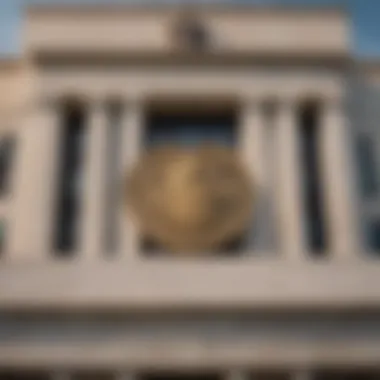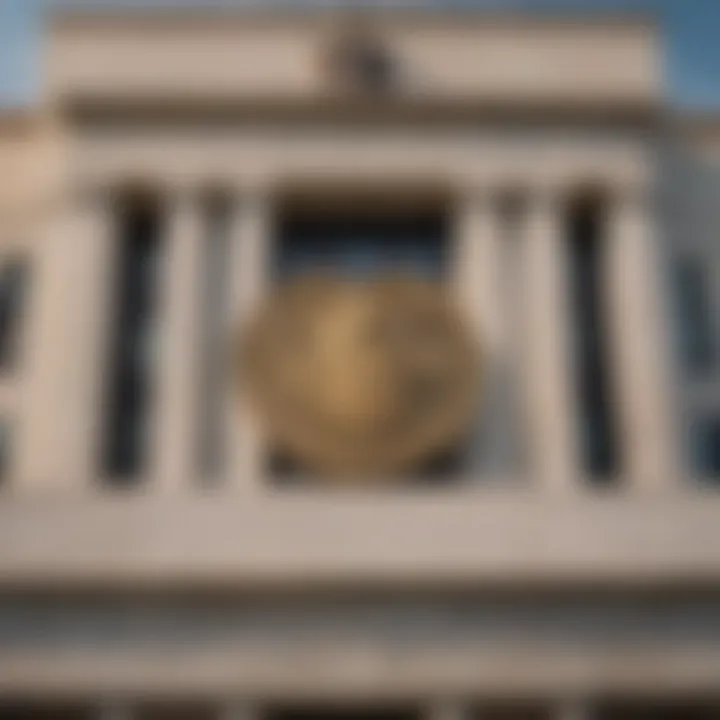The Last Time the Fed Raised Interest Rates: Insights


Intro
The landscape of finance often feels like a puzzle, especially when pivotal decisions are made by institutions such as the Federal Reserve, often simply referred to as the Fed. Understanding the last interest rate hike by the Fed opens a window into the broader economic narrative. It involves figuring out the backdrop of economic conditions, the motives behind the hike, and how the change rippled across various sectors.
For beginner and seasoned investors alike, grasping these insights is essential for navigating the financial waters.
Key Terms and Definitions
Explanation of Investment Terminology
When discussing the implications of an interest rate hike, it’s vital to familiarize oneself with some key financial terminology:
- Interest Rate: This is the percentage charged on borrowed money, or earned on investments. A rise can mean higher costs for loans and potential returns for savers.
- Monetary Policy: Actions undertaken by a nation's central bank to control money supply, interest rates, and overall economic health.
- Liquidity: Refers to how easily assets can be bought or sold in the market without affecting the asset's price.
- Asset Allocation: This involves diversifying investments across various asset categories to minimize risk.
Commonly Used Financial Products
As investors consider strategies in the wake of a rate hike, understanding common financial products is critical:
- Bonds: Debt securities where investors lend money to an entity in exchange for periodic interest payments and return of principal at maturity.
- Stocks: Shares of ownership in a company, which can fluctuate in value based on a multitude of factors.
- Mutual Funds: Pooled funds from multiple investors to buy a diversified portfolio of stocks, bonds, or other securities.
Economic Conditions At The Time
The last time the Fed raised interest rates, several conditions were pivotal:
- The economy was demonstrating signs of recovery post-recession.
- Unemployment rates had decreased, indicating a healthier job market.
- Inflation was nearing the Fed's target, prompting a reevaluation of monetary policy.
Understanding these underlying conditions provides an insight into the decision-making process of the Fed.
The Impact of the Hike
When the Fed raises interest rates, it impacts various sectors:
- Consumer Spending: Higher rates can lead to increased borrowing costs, potentially slowing down consumer purchases, especially for big-ticket items.
- Housing Market: Mortgage rates typically rise, which might deter some first-time homebuyers and soften housing demand.
- Stock Market Volatility: Higher interest rates can lead to cautious investor sentiment, which may create fluctuations in stock valuations.
- Bank Lending: Banks may adjust their lending practices, potentially making credit less accessible.
"Monetary policy decisions are often a balancing act. The Fed must weigh the benefits of stimulating the economy with the risks of inflation."
Culmination
In analyzing the last interest rate hike by the Fed, it's crucial to connect the dots between economic conditions and the subsequent impacts felt across different sectors. By arming oneself with knowledge of key terms and definitions, investors can better prepare for future monetary policy shifts. This understanding is not only beneficial for navigating present investments but also crucial for anticipating potential economic trends.
Historical Overview of Federal Interest Rate Changes
Understanding the historical context of federal interest rate changes is crucial for any investor or financial enthusiast. It sheds light on how the Federal Reserve's decisions affect not just the economy, but also the everyday lives of citizens. When interest rates rise or fall, the implications ripple through various sectors, influencing everything from mortgage rates to investment portfolios.
A Brief History of Interest Rate Adjustments
Interest rate adjustments have been a fundamental tool for the Federal Reserve since its inception in 1913. Each tweak in rates is usually a response to prevailing economic conditions. For example, during the 1970s, the U.S. faced stagflation, a combination of stagnant economic growth and rising inflation. In response, the Fed, led by Chairman Paul Volcker, dramatically increased interest rates to curb inflation, leading to rates soaring above 15%.
Conversely, in the wake of the 2008 financial crisis, the Fed slashed rates to record lows to stimulate economic growth. This history illustrates the Fed's tightrope walk between fostering growth while controlling inflation—a balancing act that requires careful consideration of multiple economic indicators.
Economic Indicators Prior to Recent Rate Hikes
Before the Fed decided to increase rates most recently, several key economic indicators were scrutinized. These included:
- Inflation Rates: The Consumer Price Index (CPI) demonstrated a noticeable uptick in inflation, characterized predominantly by increased prices on essentials such as food and fuel.
- Unemployment Rates: A declining unemployment rate can signal a booming economy, prompting the Fed to tighten monetary policy to prevent an overheating economy.
- Consumer Spending: Indicators of consumer confidence were high, reflected in spending trends, which often foreshadow broader economic health.
These indicators serve as the barometer against which the Fed measures its decisions, ensuring that any increase in rates does not jeopardize the income of the general populace or stifle growth.
"Understanding historical changes in interest rates is like connecting the dots in economic history; it reveals how past decisions shape today’s financial landscape."


In summary, the historical overview of federal interest rate changes is not merely about numbers; it's about understanding economic momentum and the broader implications for both investors and policymakers alike.
Context of the Last Rate Increase
Understanding the context surrounding the recent interest rate hike is crucial for grasping the full picture of its implications. It sheds light on why the Federal Reserve makes these decisions and helps us comprehend the underlying economic forces at play. By focusing on these facets, investors and financial enthusiasts can be better equipped to navigate the complexities of the monetary landscape.
Key Economic Factors at Play
Several key factors contributed to the Fed's decision to raise interest rates. The labor market was at the forefront, showing signs of strength with consistently low unemployment rates. This, along with rising wages, hinted at a tightening economy that might spur inflation. The inflation rate itself was pushing above the target set by the Fed, hovering around 3%, raising red flags for policymakers.
Additionally, global economic conditions influenced the decision. Trade tensions and geopolitical uncertainties put pressure on markets, necessitating preemptive action from the Fed. The combination of domestic growth amid international headwinds painted a nuanced picture, urging the Fed to act decisively in securing economic stability.
- Low Unemployment: The unemployment rate had reached a historically low level, suggesting a tight labor market.
- Wage Growth: Increasing wages could fuel consumer spending, pushing inflation higher.
- Increased Inflation: Rates rising above the set target required a response to keep economic growth in check.
- Global Considerations: Trade conflicts and overseas economic fluctuations put additional strain on decision-making.
Central Banking Philosophy and Strategy
The philosophy underpinning the Fed's action also speaks volumes about its approach to monetary policy. The central bank tends to prioritize stable prices and maximum employment, balancing these objectives with its dual mandate. However, it's not just about reacting to current conditions; it involves anticipating future trends.
When the Fed adjusted rates, it reflected its commitment to controlling inflation in a dynamically evolving economy. Constantly scanning for threats to its objectives, the Fed adopted a proactive posture, ensuring that the economy remained on a steady path. This philosophy drives the rhythmic pulse of interest rates, as the Fed seeks to inject stability into the often turbulent waters of the economy.
"The Fed's decisions are not made in a vacuum; they are part of a broader strategy aimed at fostering a healthy economic environment."
The implications of these philosophical stances manifest in various ways, directly affecting a myriad of sectors in the economy—from housing to consumer goods. By cleverly navigating interest rates, the Fed aims to not just respond to economic currents but also to steer them.
In summary, the context of the last rate increase unveils a complex interplay of economic indicators and banking philosophy that investors must grasp. Understanding these elements will help demystify future monetary policy moves, enabling both seasoned and novice market participants to make informed decisions.
The Decision-Making Process of the Fed
The Federal Reserve plays a crucial role in shaping the economic landscape through its interest rate decisions. Understanding the decision-making process of the Fed is essential for grasping how these interest rates affect everything from consumer loans to the stock market. The Federal Open Market Committee, often referred to as the FOMC, is at the heart of this process. Their decisions are not made lightly; they are based on a complex blend of economic indicators, financial trends, and overarching monetary policy goals.
The FOMC meets regularly, typically every six to eight weeks, to evaluate current economic conditions and forecast future trends. This systematic approach allows the committee to navigate the turbulent waters of the economy with a steady hand. Each member brings a unique perspective, informed by research and data analysis, ensuring that diverse views are considered. This collective effort, often described as consensus-driven, serves to reinforce the importance of collaboration in monetary policy decisions.
How the Federal Open Market Committee Works
The FOMC consists of 12 voting members, including seven members of the Board of Governors and five Reserve Bank presidents who rotate as voting members. Their discussions are highly detailed, focusing on various economic data points such as inflation rates, employment figures, and the overall health of the financial system. It's worth noting that the FOMC does not operate in isolation; they actively collaborate with economists and analysts across the Federal Reserve System to gather comprehensive insights.
When it comes down to making decisions, they utilize a framework known as the Taylor Rule, which posits a relationship between short-term interest rates, inflation, and economic output. Effective communication is also a pillar of this committee. Following each meeting, the Fed releases a statement summarizing their decisions, which serves to inform the public and foster transparency in their actions.
Indicators that Influenced the Rate Hike Decision
Several key indicators influence the FOMC's decisions regarding interest rates:
- Inflation Rates: The Fed closely monitors inflation, aiming for a target rate of about 2%. When inflation accelerates beyond this target, it often prompts discussions around raising interest rates.
- Unemployment Rates: A low unemployment rate signals economic growth but can also lead to wage inflation. If unemployment drops too low, the Fed may consider adjusting rates to prevent overheating.
- Consumer Spending: As consumer confidence rises, spending typically increases, bolstering economic growth. However, this can trigger inflationary pressures, leading the Fed to raise rates.
"The FOMC operates on the principle that a proactive stance in monetary policy can mitigate economic downturns and stabilize inflation rates."
- Global Economic Conditions: The interconnectedness of the world economy means that international developments can have ripple effects domestically. Events like trade wars or economic slowdowns in major economies can impact the FOMC's strategy.
- Market Reactions: The Fed also pays attention to how the financial markets are reacting. A volatile market can indicate uncertainty or potential risks, prompting the FOMC to tread carefully with rate changes.
By examining these indicators, the Fed can make informed and strategic decisions regarding interest rates, which in turn shapes the economic environment. This multifaceted approach ensures that the FOMC is not only reactive but also proactive, aiming to foster sustainable economic growth.
Immediate Effects of the Rate Increase
The decision to rise interest rates by the Federal Reserve sends ripples through multiple sectors of the economy, creating immediate and tangible effects. Understanding these effects is crucial, as they inform investors about market dynamics and consumer behavior. When rates climb, borrowing costs rise, which doesn’t just impact individuals; it shapes the broader economic landscape. Thus, exploring the immediate fallout of such a decision offers insights into how the economy reacts in real-time and prepares investors for potential shifts ahead.
Impact on Financial Markets
Financial markets generally react swiftly to changes in interest rates. When the Fed increases rates, bond yields usually rise. This is because new bonds must offer higher returns to attract investors, leading existing bond prices to drop. For example, if you had a bond yielding 2% at a previous rate, a new bond offering 3% becomes more attractive. This scenario can lead to:
- Increased volatility: Stock markets often experience turbulence shortly after a rate hike. Investors readjust portfolios, which can cause fluctuations.
- Sector rotations: Certain sectors, like utilities and real estate, typically don’t perform well when rates increase. Conversely, financial stocks might often see a fresh rally as banks can charge more for loans.
"When rates increase, it's like pulling the brake on a speeding car: everything can shift unexpectedly."


The implication here is that investors need to stay sharp. Typically, risk assessments change, creating opportunities or threats depending on financial positioning. For instance, tech stocks, characterized by high growth expectations, may suffer as higher rates put pressure on future earnings. Investors need to be astute, observing how equities respond, and position themselves accordingly.
Changes in Consumer Lending Rates
As soon as interest rates rise, the cost of borrowing tends to go up directly. This shift is felt by consumers in various ways, particularly through:
- Mortgage rates: The housing market is often affected as mortgage rates climb, dampening home buying efforts. Buyers might pull back or reconsider affordability. This, in turn, can slow down housing market growth, affecting construction and related sectors.
- Credit card rates: Credit card interest rates often follow suit, increasing the cost of carrying a balance. This is significant. If consumers feel pinched, they might cut back on discretionary spending, which could slow economic growth overall.
- Auto loans: Higher rates make financing a car more expensive. This could lead to decreased demand in the automotive sector, putting pressure on auto manufacturers and dealers.
In essence, these changes lead to a tightening of consumer financial conditions, impacting discretionary spending and overall economic activity. The consumer’s response to these increased costs can either cushion or aggravate the overall economic narrative. Understanding these immediate effects not only arms investors with knowledge but also enables them to make educated decisions in facing such shifts.
Broader Economic Consequences
Understanding the broader economic consequences of the last interest rate hike is essential for grasping the full impact of the decision made by the Federal Reserve. Changes in interest rates don't happen in a vacuum; they reverberate throughout the economy in various ways, influencing inflation, consumer behavior, and overall growth. The nuances of these ramifications are critical, not only for policymakers but also for individuals and businesses alike.
Effects on Inflation Trends
When interest rates are raised, one of the primary objectives is to control inflation. Higher rates generally make borrowing more expensive, which in turn can dampen consumer spending and business investments. For instance, consider a family thinking about purchasing a new home. With elevated interest rates, their monthly mortgage payments would increase, possibly pushing them to prioritize savings over spending.
This mechanism can lead to a slowdown in demand, indirectly helping to keep inflation in check. As companies see reduced sales, they might hold back on raising prices, thereby contributing to lower inflation rates. Therefore, monitoring the inflation trends post-rate increase provides vital insights into the effectiveness of the Fed’s policies.
Recent data reflects some significant shifts. For example, inflation rates have shown signs of moderation after the last hike, supporting the argument that the Fed's strategy is working. However, it’s a delicate balancing act. If inflation remains stubbornly high despite increased rates, the Fed might have to continue raising rates, creating a compounding effect that could further suppress economic activity.
"A higher interest rate environment could lead to a paradoxical situation: while aiming to uplift the economy, the Fed risks stifling it instead."
Potential Risks to Economic Growth
The relationship between interest rates and economic growth can be compared to walking a tightrope; if the balance tips too far, consequences can quickly become dire. A significant increase in interest rates can slow down consumer spending and business expansion. Higher borrowing costs can dampen capital spending, putting a damper on growth prospects.
Certain sectors are particularly sensitive to these fluctuations. For example:
- Consumer Goods: As borrowing becomes more expensive, people might delay purchases of non-essential items. This can lead companies to experience reduced revenues and, potentially, layoffs.
- Real Estate: Elevated mortgage rates can shrink the pool of prospective homebuyers, thus slowing down the housing market and affecting industries linked to real estate.
- Manufacturing: Businesses often rely on borrowing to fund expansion operations. Increased rates can create hesitation or delay in investing, leading to stagnation in growth.
If the economy contracts due to these heightened rates, unemployment may rise, consumer confidence could drop, and the downward spiral often becomes hard to reverse.
As we analyze these outcomes, it becomes clearer why the Fed has to tread carefully with rate adjustments. The potential risks to economic growth challenge the idea that higher interest rates are solely beneficial in controlling inflation. This interplay between inflation control and growth is a dynamic that every investor should keep a keen eye on.
Long-Term Implications for Investors
When it comes to the long-term implications of the Federal Reserve's interest rate hikes, understanding the ripple effects is crucial for anyone involved in the market. Investors need to think beyond immediate outcomes and consider how these decisions can shape their future strategies. The interplay of interest rates with economic conditions acts like a dial that influences various facets of investment. If the Fed raises rates, it often signals confidence in the economy, but it can simultaneously indicate that financial conditions are tightening.
Adjusting Investment Strategies
Adapting investment strategies in response to interest rate changes is not just wise; it's essential. A rate increase typically leads to higher borrowing costs, which in turn can slow down economic growth and reduce consumer spending. For investors, this suggests a need to re-evaluate portfolios.
- Diversification: Now may be the time to explore sectors that perform well in high-interest environments, like financials and real estate. Sectors such as utilities and consumer staples, which may lag, could affect balanced portfolios.
- Bond Holdings: With rising rates, bond prices tend to drop. Long-term bonds, in particular, may feel the pinch, so shifting to shorter-dated bonds could mitigate risk.
- Stock Valuation: Growth stocks that rely on cheap capital might see their valuations take a hit. Thus, investors might reevaluate stocks with solid fundamentals and return potential versus speculative plays.
By adjusting strategies proactively, novice and experienced investors alike can adapt to a changing market landscape and potentially buffer their investments against adverse effects.
Sector-Specific Predictions
Looking at the potential impact of these shifts at the sector level is paramount. Here are a few sector-specific predictions following the most recent rate increase:
- Financial Services: As rates rise, banks could benefit from wider interest margins. Consequently, investing in established financial institutions should be on the radar for future gains.
- Real Estate: Higher rates often push mortgage rates up, leading to potential slowdowns in the housing market. Thus, real estate investors may want to proceed with caution, perhaps looking more closely at rental properties or REITs that can handle increased costs.
- Utilities: Typically, this sector doesn’t fare as well amid rising rates since they are often viewed as high-dividend plays. If borrowing costs increase, utilities might face pressure.
- Consumer Discretionary: Consumer spending patterns can shift, and industries reliant on financing might see a downturn. Investors should remain alert to changing consumer behaviors and adjust stock positions accordingly.
Understanding which sectors to favor or avoid can provide a significant advantage, guiding decisions that safeguard investments in the long run.
In summary, the long-term implications of the Fed's rate hikes require careful analysis and a thoughtful approach to investment strategy. Doing the homework now could lead to benefits later, ensuring that investors are well-positioned for whatever the economic landscape may bring.
Comparative Analysis with Previous Rate Increases


Understanding the nuances of comparative analysis with previous rate increases not only sheds light on the current economic environment but also unveils patterns that may guide future decisions. When the Federal Reserve adjusts interest rates, it doesn’t happen in isolation; it’s a response to a larger set of indicators, economic behaviors, and overarching monetary philosophies that have developed over time.
Many investors and financial enthusiasts often look at past hikes to draw parallels and make educated predictions. Such comparisons can provide context regarding market reactions, historical outcomes, and the reasoning behind each decision. Recognizing the distinctive elements that made each rate hike unique enables stakeholders to navigate today’s financial landscape with a sharper perspective.
Lessons from Past Hikes
Historically, each rate hike has been a reflection of the economic climate at that time. For instance, looking back to the late 1970s and early 1980s, the Fed raised interest rates dramatically to combat spiraling inflation, which had an immediate cooling effect on consumer spending and borrowing, but it also paved the way for sustainable growth in the years that followed.
- Volatility in the Markets: Each rate increase often initially triggers volatility. For example, prior to the hikes in the early 2000s, there were substantial swings in stock prices. Investors reacted swiftly, selling off shares in anticipation of tighter monetary conditions.
- Long-Term Growth vs. Short-Term Pain: Rate hikes can lead to decreased lending, which may slow down capital spending. Yet, these decisions are often justified if they lead to a healthier economy in the long run. The aftermath of the 2006 increase, which aimed to curb housing market speculation, is a testament to this—as painful as it may have been, it helped to stabilize the market eventually.
As we analyze these lessons, it becomes clear that patience can often yield rewards, even when immediate results feel unnerving.
Market Responses Over Time
Over the decades, the responses of financial markets to rate changes have evolved significantly. In earlier periods, like the 1980s or 1990s, investors had a more reactive approach, guided by fear and uncertainty. Nowadays, markets tend to adopt a more analytical perspective, trying to decipher the Fed's intentions rather than just reacting to rate changes.
- Increased Investor Savvy: More information is available today through digital media. Investors are swifter at processing data around economic indicators, consumer confidence, and inflation rates. They no longer rely solely on the Fed's announcements.
- Sector-Specific Reactions: Different sectors react to rate changes in distinct ways. For example, financial services generally benefit from increased rates as it becomes more profitable to lend. Conversely, the real estate sector may feel a pinch since higher rates can deter homebuyers. Recognizing these sectoral dynamics is crucial for investors.
As we look back and understand how markets have responded historically, we can draw clearer insights about potential future trends, ensuring that decisions are not made in a vacuum but rather with an eye on the past.
"Those who cannot remember the past are condemned to repeat it." - George Santayana
In summary, examining previous rate increases provides invaluable context for today’s economic conditions. By learning from history, both seasoned and novice investors can refine their strategies and make informed decisions. The dual forces of patience and informed analysis remain critical for navigating the complexities of monetary policy.
If you want to explore further historical data and impacts of previous rate hikes, you can check resources on Wikipedia or Britannica.
Understanding where we have been can help clarify where we are going.
Reflections on Monetary Policy Goals
Understanding the nuances behind monetary policy goals is crucial, especially in light of the Federal Reserve's last interest rate hike. This is an area that transcends mere numbers; it delves into how monetary policy shapes the overall economic landscape and influences the livelihoods of countless individuals and businesses. When examining these goals, it becomes clear that they stem from a desire to maintain stability and foster sustainable growth within the economic framework.
Objectives of Interest Rate Adjustments
The primary objective when the Fed adjusts interest rates typically revolves around controlling inflation and ensuring economic growth. There are several key aims baked into this objective:
- Inflation Control: Keeping an eye on rising prices helps maintain purchasing power, which is fundamental for consumer confidence.
- Employment Levels: Lowering rates can stimulate spending, which in turn can lead to job creation.
- Economic Stability: A fine balance between growth and recession can set the stage for longer-term prosperity.
When the Federal Reserve sets interest rates, it navigates a delicate path. Decisions taken must account for both present conditions and projections about future economic behavior. For instance, during circumstances of economic turbulence, a rate increase could seem necessary; however, one misstep could set off a chain reaction that affects growth adversely.
Future Challenges for the Fed
Looking ahead, the Fed faces multiple hurdles as it tries to implement its monetary policy effectively. Some of the notable challenges include:
- Global Economic Conditions: With interconnected global markets, shifts in economic trends abroad can ripple back and affect domestic objectives, complicating the Fed's stance.
- Technological Advancements: The rise of fintech and digital currencies create uncharted territory. Regulations and existing frameworks face pressure to adapt.
- Political Pressures: Balancing independence while fending off political influence is an ongoing challenge for the Federal Reserve, as public sentiment can skew how policies are perceived.
"In order to successfully navigate these waters, the Fed must remain vigilant, adaptable, and most importantly, transparent."
Ending: Understanding the Big Picture
When we fold the final pages on the discussion of the last interest rate increase by the Federal Reserve, it’s plain to see that understanding its bigger implications is crucial. This isn’t just about numbers that flash on a screen; it’s a reflection of economic health, potential growth paths, and investor sentiment. Each rate hike isn’t a mere bureaucratic decision—it’s a response to complex interplays within the economy, influencing not only markets but also individuals trying to make sense of their financial futures.
The Fed’s movement upwards in rates indicates confidence in the economy but does also come with a warning sign. Higher rates can lead to tighter financial conditions, which may slow down growth in certain sectors. Investors, be they rookies or veterans, must grasp that these shifts come with waves of opportunities and pitfalls. Ignoring the potential implications can be a costly oversight. Understanding how the last increase ties into a broader narrative of monetary policy helps investors shape their strategies effectively.
Key Takeaways from the Last Rate Increase
- Economic Context: The last rate hike was a product of various economic indicators pointing towards growth—unemployment rates were low, and inflation was creeping up, making the decision both timely and necessary.
- Market Reactions: Observing market responses to such announcements sheds light on investor optimism or concern. Stocks may react negatively while bonds may see an uptick, reflecting shifting investor preferences.
- Sector-Specific Impacts: Not all sectors respond equally. For example, financials may benefit from rising rates through improved margins, while real estate may feel the pinch from higher borrowing costs.
- Long-term Perspectives: An increase in rates should not be viewed in isolation. It’s part of an ongoing cycle in monetary policy which requires adjusting strategies to ensure sustainability and growth over time.
"Economic cycles do not exist in a vacuum; they dance to the tune of monetary policies, fiscal strategies, and global events."
Looking Forward: What Might Come Next?
In the wake of the last interest rate hike, the air is thick with speculation about what lies ahead. Financial markets often meander in alignment with expectations, particularly regarding future Fed decisions.
- Potential Future Increases: Analysts are watching like hawks for signals that might point toward more hikes. If inflation persists or if economic growth remains strong, the Fed may consider further adjustments.
- Global Economic Factors: The interconnectedness of global economies means that developments abroad can create ripples back home. For instance, economic slowdowns in significant markets could influence the Fed's decisions, as they consider potential impacts on export strength.
- Investors’ Playbook: Investors might recalibrate their portfolios based on anticipated shifts in interest rate policy. Sectors that traditionally thrive in a low-rate environment may need a second look, while others could emerge as winners in an era of higher rates.
Wading through the currents of monetary policy and its implications requires a blend of vigilance and strategic foresight. Investors need to keep their fingers on the pulse of economic indicators to adjust their sails. Understanding the last rate increase allows for a clearer lens to view the evolving landscape of finance.



